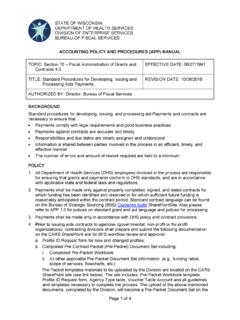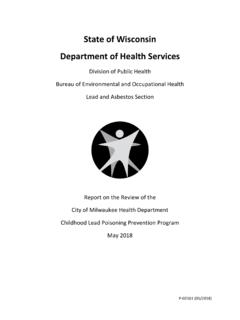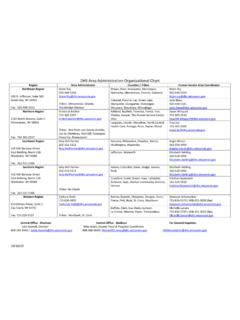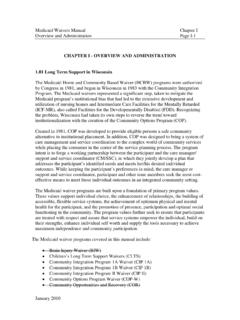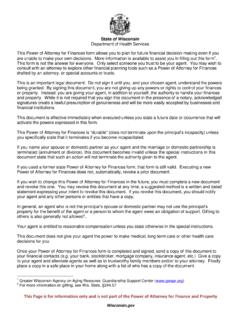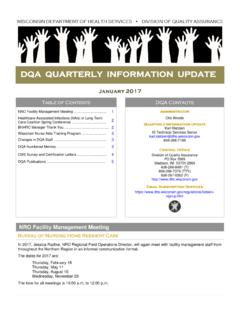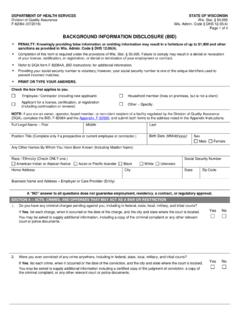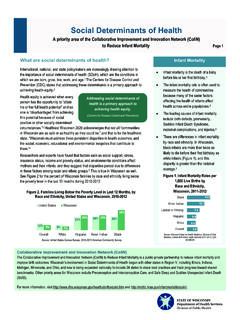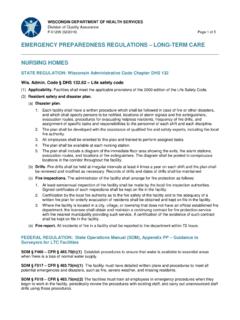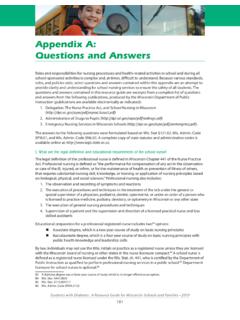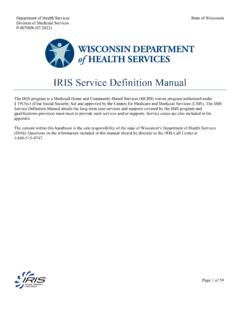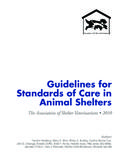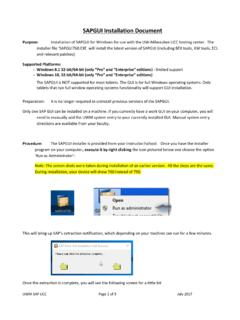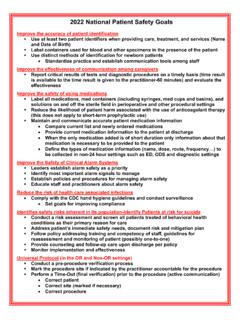Transcription of Assisted Living COVID-19 Testing Guidance - Wisconsin …
1 Assisted Living COVID-19 Testing Guidance State of Wisconsin / Department of Health Services / Division of Quality Assurance P- 02768 (09/2021) 1 This Testing Guidance is for community-based residential facilities (CBRFs), 3-4 bed adult family homes (AFHs), and residential care apartment complexes (RCACs). COVID-19 remains highly contagious and continues to spread across Wisconsin . The Department of Health Services (DHS) has identified resources to support outbreak Testing , routine/expanded Testing , and symptomatic/exposure Testing of individual residents/staff. The most effective way to mitigate the harm of COVID-19 is prevention. Assisted Living facilities are encouraged to regularly review DHS and Centers for Disease Control and Prevention (CDC) Guidance at COVID-19 : Guidance for Health Care Professionals and Residential Care Facilities, Infection Prevention and Control Recommendations for Staff, Infection Prevention and Control Recommendations to Prevent the Spread and Coronavirus Disease: What To Do If You Are Sick.
2 Facilities are also encouraged to plan ahead for cases using the DHS LTCF Outbreaks Guide. WHO TO TEST Symptomatic/Exposure Testing of Individual Residents/Staff Outbreak Testing of All Residents/Staff Routine/Expanded Testing of Unvaccinated Staff WHEN TO TEST Upon exhibiting any COVID-19 -compatible signs or symptoms. Asymptomatic staff with a higher-risk exposure and residents with close contact with someone with SARS-CoV-2 infection, regardless of vaccination status, should have a series of two viral tests for SARS-CoV-2 infection. In these situations, Testing is recommended immediately (but not earlier than 2 days after the exposure) and, if negative, again 5 7 days after the exposure. Testing is not recommended for people who have had SARS-CoV-2 infection in the last 90 days if they remain asymptomatic, including if they have had close contact or a higher-risk exposure; this is because some people may be non-infectious but have detectable virus from their prior infection during this period (additional information is available).
3 Upon identification of a single new case of COVID-19 infection in any staff or resident. Facilities have the option to perform outbreak Testing through two approaches, contact tracing or broad-based Testing . If the facility has the ability to identify all close contacts of the individual with COVID-19 , they could choose to conduct focused Testing based on known close contacts. If a facility does not have the expertise, resources, or ability to identify all close contacts or if contacts extend beyond the level of a targeted approach, they should instead investigate the outbreak at a facility-wide or group-level ( , unit, floor, or other specific area(s) of the facility). Perform Testing for all residents and staff, per the selected level of outbreak Testing (targeted contact tracing or wider approach) regardless of vaccination status, immediately (but not earlier than 2 days after the exposure, if known) and, if negative, again 5-7 days later.
4 Expanded screening Testing of asymptomatic staff should be as follows: Fully vaccinated staff may be exempt from routine/expanded Testing . Unvaccinated staff should continue routine/expanded Testing based on the level of community transmission as follows: o In counties with substantial and high community transmission, unvaccinated staff should have a viral test twice a week. o In counties with moderate community transmission, unvaccinated staff should have a viral test once a week. o In counties with low community transmission, expanded screening Testing for asymptomatic staff, regardless of vaccination status, is not recommended. Instead, be prepared to test asymptomatic and exposed staff and residents. o If unvaccinated staff work infrequently at these facilities, they should ideally be tested within the 3 Assisted Living COVID-19 Testing Guidance State of Wisconsin / Department of Health Services / Division of Quality Assurance P- 02768 (09/2021) 2 If additional cases are identified, Testing should continue on affected unit(s) or facility-wide every 3-7 days until there are no new cases identified for at least 14 days.
5 If antigen Testing is used, more frequent Testing (every 3 days), should be considered. If no additional cases are identified after initial Testing , consider Testing at the end of the incubation period (day 14 of exposure). Those that test positive are exempt from re- Testing for 90 days unless they develop new symptoms. days before their shift (including the day of the shift). Reports of county COVID-19 level of community transmission is available on the following website: #county-view Fully vaccinated refers to a person who is 2 weeks following receipt of the second dose in a 2-dose series, or 2 weeks following receipt of one dose of a single-dose vaccine. PREFERRED TEST TYPE Point-of-care (POC) antigen* Testing and, as applicable, confirmatory PCR Testing based on Guidance from Health Alert #17 PCR Testing ** PCR Testing ** * In order to perform POC Antigen Testing , the facility must have a CLIA waiver and must report all test results (positive and negative) to the Department of Health and Human Services (DHHS) and all positive results to the state.
6 ** The preferred Testing method for outbreak and routine Testing is PCR and should be the primary method of Testing . However, facilities may choose to use antigen* Testing per Health Alert #17 Guidance . WHO COLLECTS SAMPLES PCR/antigen: Licensed or trained individual (see training Guidance below) FDA EUA-authorized, at-home test: Individual being tested or trained staff PCR/antigen: Licensed or trained individual (see training Guidance below) FDA EUA-authorized, at-home test: Individual being tested or trained staff PCR/antigen: Licensed or trained individual (see training Guidance below) FDA EUA-authorized, at-home test: Individual being tested or trained staff Assisted Living COVID-19 Testing Guidance State of Wisconsin / Department of Health Services / Division of Quality Assurance P- 02768 (09/2021) 3 OBTAINING SUPPLIES FOR Testing Ensure Testing supplies are on hand to test as needed. For state-sponsored PCR or POC test supplies, submit your request for supplies through the ordering website.
7 Facilities will be paired with a lab and provided Testing supplies if Testing for the first time. As an alternative to the above, facilities can still utilize community Testing sites. When you have identified one staff or resident positive for COVID-19 : 1. Call your local/tribal public health department (LTHD) to confirm outbreak status. 2. If the LTHD determines outbreak Testing is required at your facility, order Testing supplies at 3. The DHS Testing Customer Outreach Team will then contact you regarding your order and partner you with a lab that will process your tests. Do not call the lab until instructed to do so. For state-sponsored PCR or POC test supplies, submit your request for supplies through the ordering website. Facilities will be paired with a lab and provided Testing supplies if Testing for the first time. If you have questions about ordering Testing supplies, email Guidance AND RESOURCES Questions about Testing in Assisted Living can be directed to the LTHD.
8 Testing Regulations 1. All tests must be ordered by a clinician. a. POC antigen test standing order b. PCR test standing order 2. All POC Testing must be performed under a CLIA certificate or a certificate of waiver. (See Guidance below.) 3. COVID-19 is a Category I reportable condition in Wisconsin . As such, all suspect and confirmed COVID-19 cases should be reported to LHDs within 24 hours of detection. (See Guidance below.) 4. Facilities must obtain consent prior to Testing . a. DQA form F-02658A, COVID-19 Testing Resident/Patient/Client Consent b. DQA form F-02658, COVID-19 Testing Staff Consent Assisted Living COVID-19 Testing Guidance State of Wisconsin / Department of Health Services / Division of Quality Assurance P- 02768 (09/2021) 4 Types of Testing Available to ALFs Lab-based molecular PCR tests detect viral RNA, genetic material of the virus. These remain the gold standard for clinical diagnostic detection of SARS-CoV-2 because of their high level of accuracy.
9 The samples are obtained within the facility by a trained or licensed individual and then sent for processing. These are processed at a laboratory and results are generally reported within 72 hours from receipt at the lab. The labs that process the samples report the results per state and federal requirements. Rapid point of care (POC) antigen tests detect viral proteins in patient samples. They provide rapid, qualitative results indicating the presence of the virus in a specimen. There are several antigen tests that are approved for use in the Results can be provided in as little as 15 minutes. POC Testing requires a CLIA certificate of waiver for the facility to perform Testing . Facilities doing this Testing are required to report their own results according to state and federal requirements. POC tests are simple, inexpensive, and have faster results than lab-based PCR tests. They are less accurate than PCR tests; however, and may require confirmatory laboratory Testing .
10 See HAN #17. Reporting Requirements of Antigen and PCR Molecular Testing COVID-19 results are reportable according to state and federal statute (reporting and surveillance Guidance at DHS). A CLIA-certified laboratory or Testing site must report antigen diagnostic test results to the local, state, tribal, or territory health department in accordance with Public Law 116-136, 18115(a) and the Coronavirus Aid, Relief, and Economic Security (CARES) Act. Report results to the Wisconsin State Laboratory of Hygiene (WSLH) by web-based laboratory reporting (WLR). WSLH sends the results to both DHHS and to Wisconsin electronic disease surveillance system (WEDSS) according to local, state, and federal reporting requirements and reduces the amount of reporting a facility has to perform. To report by WLR sign up for an account with WSLH. Once you have an account, submit results each day you perform Testing by uploading a spreadsheet. If you are having trouble using WLR, you can contact WSLH to help troubleshoot your issues at or 608-224-4274.
